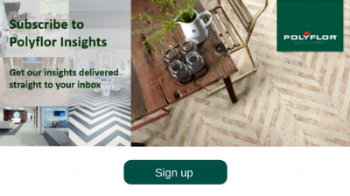Discover the different types of wall protection and the associated benefits. Understanding the products will provide insight and direction in planning a well-designed facility. This will allow you to fully captilise on all of the accompanying advantages as well as empower your project decisions going forward.
Uncover the different products in this article and browse through the reasons for wall protection featured insights article which includes advantages, design benefits and tips.
Our last article focused on the benefits of using wall protection in a building. These include:
- damage limitation
- good hygiene
- decreased maintenance
- repair and replacements costs
- aesthetic and design enhancement
- improved traffic flow
- clever non-verbal communication
- assistance to the visually impaired by the use of colour contrast
To realise these benefits it's important to understand which wall protection products are available and where best to use them. A good supplier will help you conduct a thorough needs analysis to determine where and what you need. Doing this properly is a big cost-saver; it is counter-productive to provide protection where it is not needed and to neglect protection where needed most.
The different types of wall protection products on offer include:
Product Types
|
Hand Rails
|
|
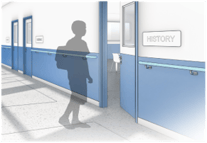
Provide pedestrian guidance, periodic rest and support in horizontal circulation areas.
Offer surface protection by preventing objects coming into contact with walls.
Handrail designs are available in a range of materials and finishes including PVC-u, aluminium, timber and stainless steel.
|
Combi Rails
|
|
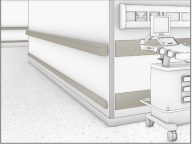 Offers both direct and indirect protection against impact from wheeled traffic. Offers both direct and indirect protection against impact from wheeled traffic.
Features a comfortable grip and thumb groove to provide reassuring pedestrian support and guidance.
Features a handrail and wall guard element combined as a single profile.
|
Dual Rails
|
|
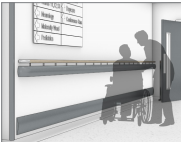 Designed to meet the specific needs in healthcare environments where pedestrian support is required in addition to protection against impact from wheeled traffic. Designed to meet the specific needs in healthcare environments where pedestrian support is required in addition to protection against impact from wheeled traffic.
Combines a traditional handrail with a PVC-u wall guard linked together with a specialist bracket.
|
Wall Cladding
|
 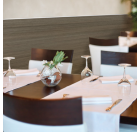 Provides a durable and defensive layer designed to protect large surfaces from scuffs and scrapes, generally caused by pedestrians and movable objects such as chairs, trolleys and tables. Provides a durable and defensive layer designed to protect large surfaces from scuffs and scrapes, generally caused by pedestrians and movable objects such as chairs, trolleys and tables.
Is available in a range of materials, colour options and finishes to coordinate with most interior design schemes and can be used in a range of applications.
Selected wall cladding can be cut or formed into rub-rails, kickplates and push-plates, door protection, corner protection and other bespoke solutions which enables functionality to be combined with aesthetics.
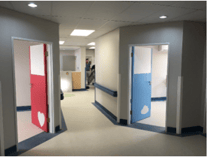 The benefits of wall cladding include: The benefits of wall cladding include:
- Durability: it provides high resistance to impact damage.
- Concealment: selecting products with an embossed finish helps to conceal the effects of impact and abrasion.
- Hygiene: it creates an impermeable barrier to moisture and bacteria. Inert materials minimise the growth of bacteria. A smooth, seamless finish is recommended for critical clean areas.
- Design: It can be used to enhance the design or aesthetics of an area or create way-finding and creative non-verbal communication.
|
PVC-u modular wall guards and bed head protectors
|
|
Bed head protectors:
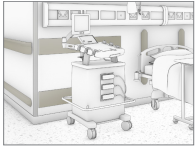
Are designed for the healthcare environment.
Protect the area and vital medical equipment above and around the bed; an area subject to high levels of damage. Traditional hospital beds were static causing minimal damage but today’s electronic beds allow more movement and result in a higher level of damage to the wall behind the bed.
Bedhead protectors are often used to protect chairs in a healthcare setting; i.e. chairs in a paediatric, dialysis or chemotherapy ward.
PVC-u modular wall guards:
Modular in construction.
Covers and accessories are replaceable and are through-coloured (i.e. the colour goes right through the product) and textured to conceal the effects of impact and abrasion.
Suitable for use in busy working environments such as hospital circulation areas, wards and corridors to protect against damage from pedestrian and wheeled traffic. |
Wall Strips
|
|
 Designed to protect against rubs and scuffs in areas such as waiting rooms, accommodation, classrooms and canteens which is typically caused by chairs, tables and other movable objects. Designed to protect against rubs and scuffs in areas such as waiting rooms, accommodation, classrooms and canteens which is typically caused by chairs, tables and other movable objects.
Cost effective alternative to wall guards to protect against damage.
|
Rubber Wall Guards
|
|

Offer robust protection against damage caused by wheeled traffic such as trolleys and carts.
Ideal for use in both interior and exterior environments such as manufacturing, warehousing, loading bays and service corridors.
We have recently launched the new R-Range which offers wall guards that are made from recycled tyres. The product is locally manufactured and will significantly reduce costs associated with maintenance of your walls.
|
Stainless Steel Wall Guards
|
|
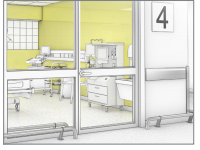
Modern, high-tech finish to enhance interior designs.
Hygienic nature of the profiles makes them ideal for use in environments such as healthcare, food and pharmaceutical preparation and manufacturing facilities.
|
Corner Guards
|
|
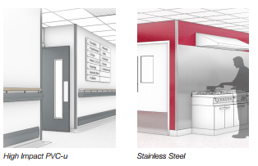 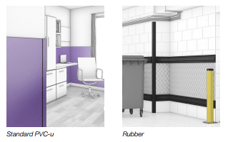 Corners are one of the most vulnerable parts of a building and when left exposed are often damaged from everyday wheeled and pedestrian traffic. Corners are one of the most vulnerable parts of a building and when left exposed are often damaged from everyday wheeled and pedestrian traffic.
Corner guards are ideal for reducing maintenance costs and maintaining interior appearances and can be combined with other protection products to provide a complete solution.
Corner guards are available in a variety of material types, styles and heights to suit all building requirements.
|
Door and Door Frame Protectors
|
|
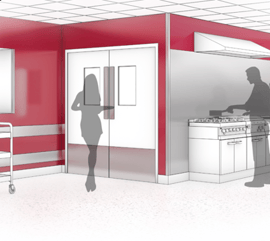 Door faces, edges and frames are vulnerable to damage due to the constant flow of pedestrian and wheeled traffic. A variety of door protection products are available to help prevent damage, conceal existing damage and highlight the door and door furniture, to assist the visually impaired Door faces, edges and frames are vulnerable to damage due to the constant flow of pedestrian and wheeled traffic. A variety of door protection products are available to help prevent damage, conceal existing damage and highlight the door and door furniture, to assist the visually impaired
Door face protection can be cut into push-plates, kickplates, door protection, cladding and other bespoke solutions.
Door edge guards come in aluminium, PVC-U and Fire-rated options.
Door frame protection sheeting offers excellent versatility in the creation of bespoke profiles, allowing functionality to be combined with aesthetics and offering an endless range of cladding possibilities. Door face protection and door frame protection can also be used together to create visual contrast to assist visually impaired people.
|
Floor Mounted Protection
|
|
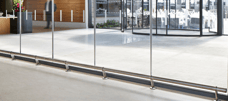 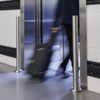 Stainless steel floor rail systems provide the ideal protection solution for surfaces that are not suitable for wall fixings, such as counters and glass partitions. Floor systems are specifically designed for keeping wheeled traffic away from the walls and can help create a sophisticated, unobtrusive finish for a modern design scheme. Stainless steel floor rail systems provide the ideal protection solution for surfaces that are not suitable for wall fixings, such as counters and glass partitions. Floor systems are specifically designed for keeping wheeled traffic away from the walls and can help create a sophisticated, unobtrusive finish for a modern design scheme.
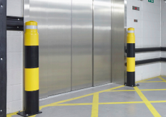 Stainless steel bollards, galvanised steel bollards with cover kits, steel core protection posts and flexible protection posts are also available to manage wheeled traffic. Stainless steel bollards, galvanised steel bollards with cover kits, steel core protection posts and flexible protection posts are also available to manage wheeled traffic.
|
Entrance Matting
|
|
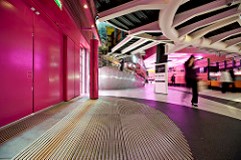 Protects building from tracked-in dirt and moisture. Protects building from tracked-in dirt and moisture.
If well designed, saves substantial amounts of cleaning and maintenance time and money
Understanding the cost of dirt in your building:
If 100 people enter your building on a daily basis, the total cost of removing dirt in SA is currently estimated to cost approx. R200 000 per year. High quality entrance matting prevents up to 80% of dirt from entering a building. Installing it at all entry points can reduce the cost to R40 000 per year. Over a 20-year period, you could save more than R3 million.
|
Conducting a needs analysis: Making sure you put the right protection in the right place
A good needs analysis will consider the area and its traffic carefully and then make recommendations. As an example, healthcare zones have to cope with heavy wheeled traffic, metal food trolleys, patient beds, medical equipment and foot traffic of staff and patients.
A systematic, thorough needs analysis (based on this expected traffic) would need to be conducted for each section of the healthcare building. The resulting specification needs to cater to the primary needs of protection but also consider other important needs such as colour coordination, aesthetics, way-finding and non-verbal communication. A reputable supplier should be able to assist you with this thorough needs analysis.
For more insights like these sign up for Polyflor Insights and we will send useful tips and advice straight to your inbox.
